课程教学大纲模板Syllabus(英文)-暂态稳定
- 格式:docx
- 大小:16.67 KB
- 文档页数:2
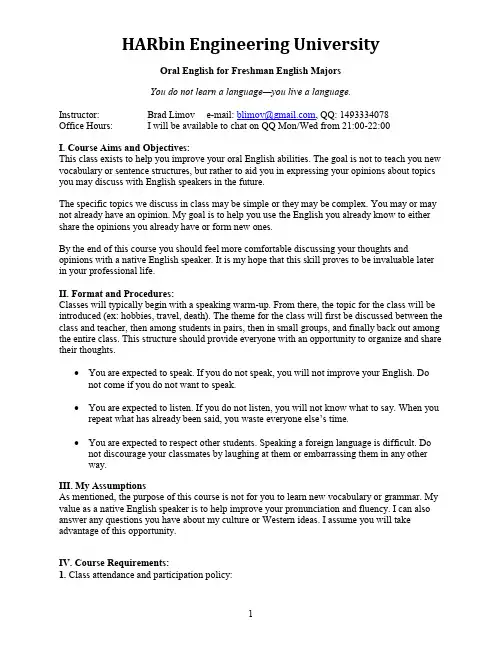
HARbin Engineering UniversityOral English for Freshman English MajorsYou do not learn a language—you live a language.Instructor: Brad Limov e-mail: blimov@, QQ: 1493334078Office Hours: I will be available to chat on QQ Mon/Wed from 21:00-22:00I. Course Aims and Objectives:This class exists to help you improve your oral English abilities. The goal is not to teach you new vocabulary or sentence structures, but rather to aid you in expressing your opinions about topics you may discuss with English speakers in the future.The specific topics we discuss in class may be simple or they may be complex. You may or may not already have an opinion. My goal is to help you use the English you already know to either share the opinions you already have or form new ones.By the end of this course you should feel more comfortable discussing your thoughts and opinions with a native English speaker. It is my hope that this skill proves to be invaluable later in your professional life.II. Format and Procedures:Classes will typically begin with a speaking warm-up. From there, the topic for the class will be introduced (ex: hobbies, travel, death). The theme for the class will first be discussed between the class and teacher, then among students in pairs, then in small groups, and finally back out among the entire class. This structure should provide everyone with an opportunity to organize and share their thoughts.∙You are expected to speak. If you do not speak, you will not improve your English. Do not come if you do not want to speak.∙You are expected to listen. If you do not listen, you will not know what to say. When you repeat what has already been said, you waste everyone else’s time.∙You are expected to respect other students. Speaking a foreign language is difficult. Do not discourage your classmates by laughing at them or embarrassing them in any otherway.III. My AssumptionsAs mentioned, the purpose of this course is not for you to learn new vocabulary or grammar. My value as a native English speaker is to help improve your pronunciation and fluency. I can also answer any questions you have about my culture or Western ideas. I assume you will take advantage of this opportunity.IV. Course Requirements:1. Class attendance and participation policy:You are expected to come to class each week. It is fine if you fall ill and have to miss a class. More than one absence is a problem.You are expected to speak during class. This means speaking in pairs, small groups, and during class discussions.2. Course readings:(a) Required text:No required text.(b) Any reading materials will be provided in class.3. Assignments:Assignments will be given each day at the end of class. You are expected to complete them. It will be obvious to me the following week if you have completed them or not.V. Grading Procedures:1. Attendance (20%)2. In-class Participation (30%)3. Assignments and Class Preparation (30%)4. Oral Examination (20%)As you can see, preparing for the discussions before class and participating in them during class accounts for 60% of your grade. You are expected to read the assigned reading and discuss the assigned prompts prior to class. You are encouraged to do this together with your fellow students.The Oral Examination will consist of questions taken from the material we have discussed in class during the semester. If you listen and speak during class, you should be fine.VI. Course ScheduleThe topics we discuss in class will be determined by student interest. If you have any topics you would like for us to discuss, feel free to tell me before/after class. You may also contact me by e-mail or QQ.At the end of every class you will be told exactly what to prepare for before our next meeting. Please prepare.。
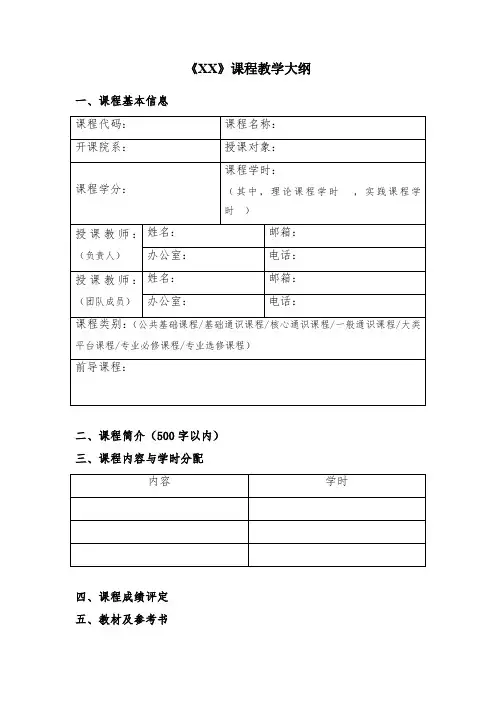
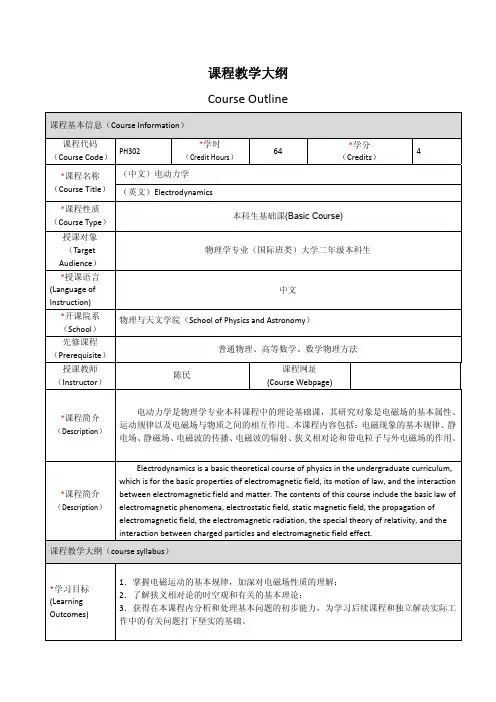
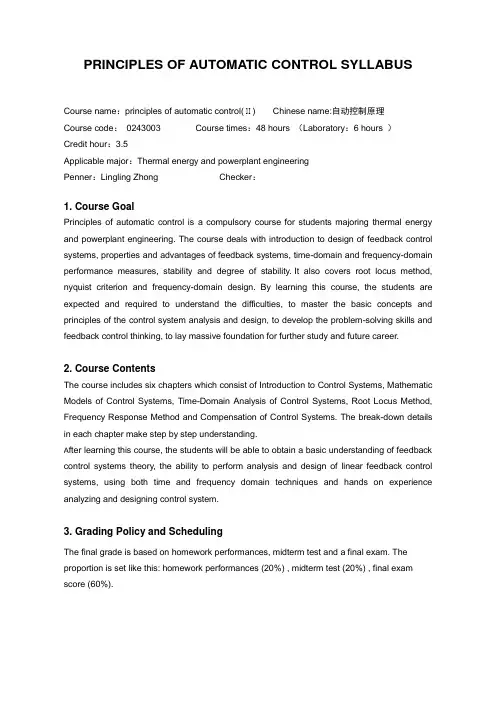
PRINCIPLES OF AUTOMATIC CONTROL SYLLABUSCourse name:principles of automatic control(Ⅱ) Chinese name:自动控制原理Course code:0243003 Course times:48 hours (Laboratory:6 hours )Credit hour:3.5Applicable major:Thermal energy and powerplant engineeringPenner:Lingling Zhong Checker:1. Course GoalPrinciples of automatic control is a compulsory course for students majoring thermal energy and powerplant engineering. The course deals with introduction to design of feedback control systems, properties and advantages of feedback systems, time-domain and frequency-domain performance measures, stability and degree of stability. It also covers root locus method, nyquist criterion and frequency-domain design. By learning this course, the students are expected and required to understand the difficulties, to master the basic concepts and principles of the control system analysis and design, to develop the problem-solving skills and feedback control thinking, to lay massive foundation for further study and future career.2. Course ContentsThe course includes six chapters which consist of Introduction to Control Systems, Mathematic Models of Control Systems, Time-Domain Analysis of Control Systems, Root Locus Method, Frequency Response Method and Compensation of Control Systems. The break-down details in each chapter make step by step understanding.A fter learning this course, the students will be able to obtain a basic understanding of feedback control systems theory, the ability to perform analysis and design of linear feedback control systems, using both time and frequency domain techniques and hands on experience analyzing and designing control system.3. Grading Policy and SchedulingThe final grade is based on homework performances, midterm test and a final exam. The proportion is set like this: homework performances (20%) , midterm test (20%) , final exam score (60%).Scheduling4. Detailed ContentsPart 1: LectureChapter 1 Introduction to control systems1) Main contents•Introduction•Basic idea and history of automatic control•Basic types of automatic control systems•Basic requirements of automatic control systems2) Emphases and DifficultiesEmphases: The basic concept of automatic control and the principle of feedback (closed-loop) control3) Teaching requirements•To understand the history, application fields and development direction of automatic control•To comprehend the basic concept of automatic control and principles of feedback (closed-loop) controlChapter 2 Mathematical models of control systems1) Main contents•Introduction to system modeling•Laplace transform•Differential Equations of simple Physical Systems•The Transfer Function of Linear Systems•Block Diagram Model•Signal-Flow Graph Models•Equivalence among Models and Summary2) Emphases and Difficulties•Emphases: The method of getting the linear differential equation and transfer function of simple physical systems. deducing and calculating the transfer function of closed-loop system using block diagram and signal flow graph•difficulties: Lapalce transform; The equivalence transform and simplification of block diagram3) Teaching requirements•To understand the basic principle and method of mathematical modeling, such as approximation, complication and similar systems•To comprehend some basic concepts such as similar systems, transfer function, typical elements, block diagram, signal-flow graph•To master the method of getting linear differential equation and transfer function of simple physical systems. Equivalence transform and simplification of block diagram.Mason’s gain formula of signal-flow graphChapter 3 Time-Domain Analysis of Control Systems1) Main contents•Basic concepts of time-domain analysis•Typical input responses and specifications•The performance of 1-order systems•The performance of 2-order systems•The performance of high-order systems•Stability analysis for linear systems•Steady-state error of linear systems•Disturbance rejection2) Emphases and Difficulties•Emphases: The concept of time response;Transient response analysis and calculation of 2-order Systems. The concept of stability; The Routh—Hurwitz stability criterion. Analysis and calculation of steady-state error•Difficulties: Transient response analysis of high-order systems. The correlation between the location of closed-loop poles and zeros and the system performance.Definitions of stability in different meanings.3) Teaching requirements•To comprehend the concepts of typical input signal, the specifications of step-response, the effects of addition of closed-loop poles and zeros •To understand the concept of stability and the sufficient and necessary condition for stability•To understand the causes of steady-state error and the ways to reduce or eliminate the steady-state error•To master the characteristics of the step response of first-order and second-order systems and their relationship with system parameters•To master the Routh—Hurwitz stability criterion•To master calculation method of steady-state errorChapter 4 Root Locus Method1) Main contents•The root locus concept•Rules for Plotting root locus•Typical root locus and extended root locus•Control system analysis and design using root locus2) Emphases and Difficulties•Emphases: The root locus concept. The root locus rules•Difficulties: To analyze system’s performance using root locus3) Teaching requirements•To comprehend the root locus concept and the method of drawing root locus•To master the rules of drawing root locus by hand and how to analyze system’s performance using root locusChapter 5 Frequency Response Methods1) Main contents•The concept of frequency response•Bode diagrams of elementary factors•Open-Loop frequency response•Nyquist stability criterion•Relative stability•Closed-Loop frequency-domain analysis•Open-Loop frequency-domain analysis2) Emphases and Difficulties•Emphases: The concept of frequency response. Frequency characteristics of typical elements. Drawing of frequency characteristics. The concept of relative stability. The Nyquist criterion. The calculation of gain and phase margins.•Difficulties: Drawing the open-loop Bode diagram of general systems. The relation between frequency performance indices and time performance indices3) Teaching requirements•To understand the measurements of frequency response, the frequency performance indices•To comprehend the concept of frequency response and the concept of relative stability •To master the frequency characteristics of typical elements and the methods of drawing the open-loop Bode diagram for general systems•To master the Nyquist stability criterion; the calculation of gain and phase marginsChapter 6 Compensation of Control System1) Main contents•Concept of compensation•Compensation networks•Phase-lead design using the Bode diagram•Phase-lag design using the Bode diagram•PID controller•Feedback compensation2) Emphases and Difficulties•Emphases: The design of phase-lead and phase-lag networks•Difficulties: The selection of phase-lead and phase-lag networks3) Teaching requirements•To understand the feedback compensation•To comprehend the concept and method of control system design•To master the procedure of phase-lead and phase-lag compensationPart 2: Laboratories1) RequirementsThere will be three lab assignments during the term. Before a laboratory, every student should make preparations for it. Each laboratory will be carried out by teams of twostudents. A lab report is required for each lab. This report is due one week after your laboratory session.2) EquipmentsLabact experiment box and PC4) ContentsLab 1:The virtual oscillograph use and experiment box verification programMain contents•Be familiar with the structure and function of every section in Labact experiment box and building experiment circuit.•Start the application of virtual oscillograph, configure communication interface, and be familiar with the UI of virtual oscillograph and the testing method of parameters.•Test the function of every section of experiment box by verification program.Teaching requirements•Master the method of building experiment circuit in Labact box•Master the usage of virtual oscillograph software•Be familiar with the box verification program and record the test resultLab 2: Time-Domain analysis of linear systemMain contents•Verify the characteristics of the step response of elementary factors (gain element, inertial element, PID). Record the result of step response by adjusting the value of resistances, capacitors, voltage or other parameter.•Verify the characteristics of transient response and stability of 2-order systems. The test system will be in underdamped, overdamped or critical damped state by adjusting the input resistance. Observe the stability of this system and record the result of step response.Teaching requirements•Mater the structure of test circuit of elementary factors and 2-order systems•Observe the result of step response of elementary factors of gain, inertial and PID. Record the experiment result.•Observe the result of step response of 2-order systems of underdamped, overdamped and critical damped. Record the experiment result.Lab 3: Frequency-Domain analysis of linear systemMain contentsResearch the affection to frequency response of the circuit structure of 2-order closed-loop systems. Calculate the natural undamped oscillatory frequency nω, the damping ratioξ,the resonant frequency mωand the resonant magnitude mM of the 2-order test system and compare with corresponding theoretical value.Teaching requirementsMater the method of calculating the natural undamped oscillatory frequency nω,the damping ratioξ,the resonant frequency mωand the resonant magnitude mM of the 2-order test system. Compare with corresponding theoretical value and think of the reason of error.5) Lab reportA lab report is required for each lab. The report should be written in the unified report paper, which includes lab name, target, theory, steps, record, data processing and result analysis. This report is due one week after your laboratory session.6) GradingThe grade will be based on the hands on ability during the experiment and lab report after the experiment, which is marked by centesimal grade. The laboratory grade accounts for 20% in the final grade.5. Course Texts and References:Course texts:[1]自动控制原理(中英文对照),李道根主编,哈尔滨:哈尔滨工业大学出版社,2007.8[2] 张德银、魏鳞、钟玲玲编.自动控制原理实验.2006Reference:[1] Modern Control Engineering: Fourth Edition, (美)Katsuhiko Ogata, 影印本,北京:清华大学出版社,2006.2[2] Modern Control Systems, 8th ed. by Richard C. Dorf, Robert H. Bishop. Translated by Xie Hongwei. Higher Education Press(高等教育出版社), 2001.06.[3] 胡寿松主编.自动控制原理简明教程.科学出版社,2003[4] 吴麒主编.自动控制原理.北京,清华大学出版社,1990。
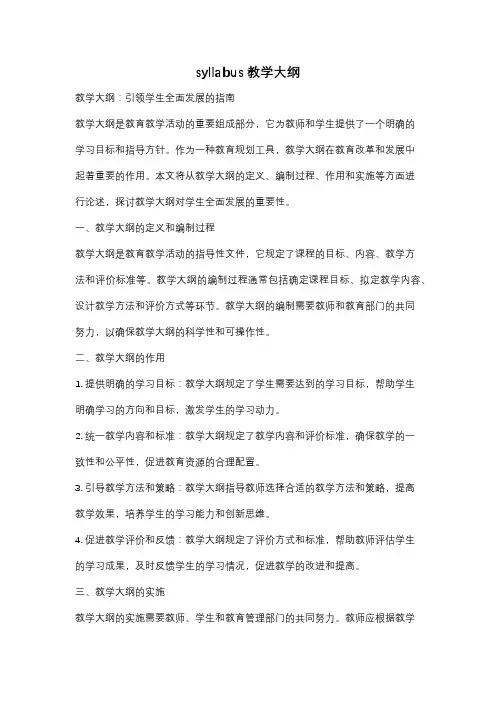
syllabus教学大纲教学大纲:引领学生全面发展的指南教学大纲是教育教学活动的重要组成部分,它为教师和学生提供了一个明确的学习目标和指导方针。
作为一种教育规划工具,教学大纲在教育改革和发展中起着重要的作用。
本文将从教学大纲的定义、编制过程、作用和实施等方面进行论述,探讨教学大纲对学生全面发展的重要性。
一、教学大纲的定义和编制过程教学大纲是教育教学活动的指导性文件,它规定了课程的目标、内容、教学方法和评价标准等。
教学大纲的编制过程通常包括确定课程目标、拟定教学内容、设计教学方法和评价方式等环节。
教学大纲的编制需要教师和教育部门的共同努力,以确保教学大纲的科学性和可操作性。
二、教学大纲的作用1. 提供明确的学习目标:教学大纲规定了学生需要达到的学习目标,帮助学生明确学习的方向和目标,激发学生的学习动力。
2. 统一教学内容和标准:教学大纲规定了教学内容和评价标准,确保教学的一致性和公平性,促进教育资源的合理配置。
3. 引导教学方法和策略:教学大纲指导教师选择合适的教学方法和策略,提高教学效果,培养学生的学习能力和创新思维。
4. 促进教学评价和反馈:教学大纲规定了评价方式和标准,帮助教师评估学生的学习成果,及时反馈学生的学习情况,促进教学的改进和提高。
三、教学大纲的实施教学大纲的实施需要教师、学生和教育管理部门的共同努力。
教师应根据教学大纲的要求,合理安排教学内容和教学方法,激发学生的学习兴趣和能动性。
学生应积极参与学习,按照教学大纲的要求,完成学习任务,并及时反馈学习情况。
教育管理部门应加强对教学大纲的宣传和培训,确保教学大纲的有效实施。
教学大纲对学生全面发展的重要性教学大纲不仅规定了学生的学习目标和学习内容,更重要的是它为学生的全面发展提供了指导和保障。
教学大纲的制定应充分考虑学生的身心发展特点和个性差异,注重培养学生的综合能力和创新思维。
教学大纲应注重培养学生的批判性思维、合作精神和实践能力,培养学生的创新意识和创新能力,提高学生的综合素质。
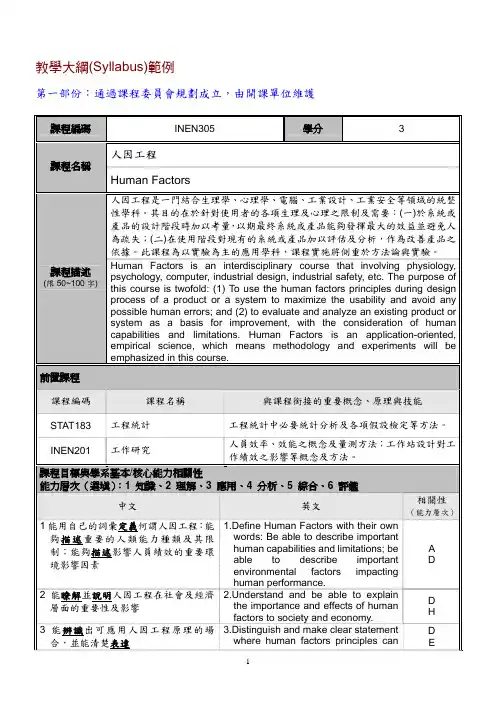
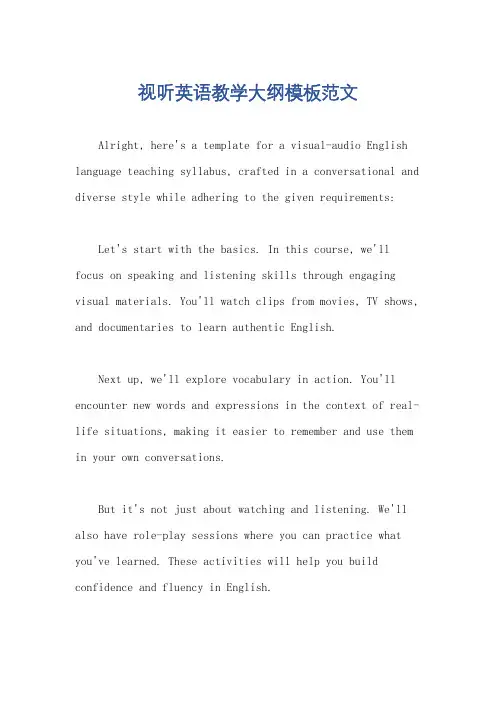
视听英语教学大纲模板范文Alright, here's a template for a visual-audio English language teaching syllabus, crafted in a conversational and diverse style while adhering to the given requirements:Let's start with the basics. In this course, we'll focus on speaking and listening skills through engaging visual materials. You'll watch clips from movies, TV shows, and documentaries to learn authentic English.Next up, we'll explore vocabulary in action. You'll encounter new words and expressions in the context of real-life situations, making it easier to remember and use them in your own conversations.But it's not just about watching and listening. We'll also have role-play sessions where you can practice what you've learned. These activities will help you build confidence and fluency in English.Culture is an essential part of language learning. Through our visual-audio materials, you'll get a glimpse into different cultures and traditions, making your English learning experience richer and more meaningful.Oh, and don't forget about pronunciation! We'll work on your accent and pronunciation skills through audio recordings and speaking exercises. You'll sound morenatural in no time.Lastly, we'll have regular assessments to track your progress. Don't worry, they won't be scary. They're just a way for us to see how you're doing and offer you additional support if needed.So there you have it!。
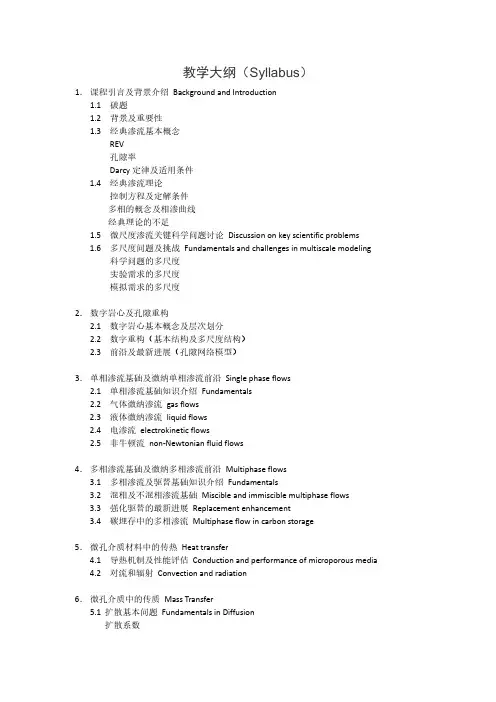
教学大纲(Syllabus)1.课程引言及背景介绍Background and Introduction1.1破题1.2背景及重要性1.3经典渗流基本概念REV孔隙率Darcy定律及适用条件1.4经典渗流理论控制方程及定解条件多相的概念及相渗曲线经典理论的不足1.5微尺度渗流关键科学问题讨论Discussion on key scientific problems1.6多尺度问题及挑战Fundamentals and challenges in multiscale modeling科学问题的多尺度实验需求的多尺度模拟需求的多尺度2.数字岩心及孔隙重构2.1 数字岩心基本概念及层次划分2.2 数字重构(基本结构及多尺度结构)2.3 前沿及最新进展(孔隙网络模型)3.单相渗流基础及微纳单相渗流前沿Single phase flows2.1 单相渗流基础知识介绍Fundamentals2.2 气体微纳渗流gas flows2.3 液体微纳渗流liquid flows2.4 电渗流electrokinetic flows2.5 非牛顿流non-Newtonian fluid flows4.多相渗流基础及微纳多相渗流前沿Multiphase flows3.1 多相渗流及驱替基础知识介绍Fundamentals3.2 混相及不混相渗流基础Miscible and immiscible multiphase flows3.3 强化驱替的最新进展Replacement enhancement3.4 碳埋存中的多相渗流Multiphase flow in carbon storage5.微孔介质材料中的传热Heat transfer4.1 导热机制及性能评估Conduction and performance of microporous media4.2 对流和辐射Convection and radiation6.微孔介质中的传质Mass Transfer5.1扩散基本问题Fundamentals in Diffusion扩散系数气体扩散问题离子扩散问题5.2复杂扩散问题:耦合对流及吸附解吸附等Complex diffusion 7.流固耦合问题(变形、断裂、运动)8.多尺度模拟前沿及总结Multiscale modeling: frontier and summary8.1 多尺度模拟的方法论Methodology8.2 多尺度模拟的未来Perspective。

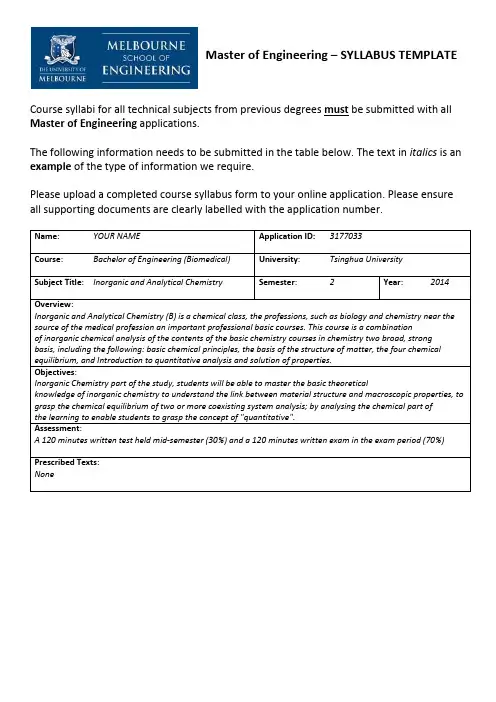
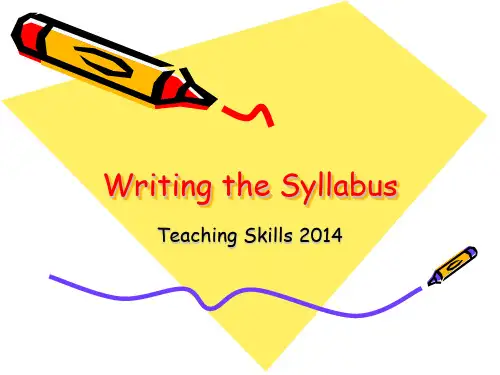
Introduction:Good morning/afternoon, esteemed audience. Today, I would like to share with you a template for an English speech on teaching syllabus. A well-structured syllabus is essential for effective teaching and learning. It outlines the course objectives, content, assessment methods, and learning activities. This template will guide you in crafting a comprehensive and engaging speech that highlights the importance of a well-designed syllabus.I. Introduction (Approx. 200 words)A. Opening remarksB. Importance of teaching syllabusC. Purpose of the speechII. Understanding the Teaching Syllabus (Approx. 300 words)A. Definition of a teaching syllabusB. Components of a teaching syllabus1. Course objectives2. Content outline3. Assessment methods4. Learning activitiesC. Benefits of a well-designed syllabus1. Clarity for both teachers and students2. Enhanced learning experience3. Improved academic performanceIII. Crafting the Teaching Syllabus (Approx. 500 words)A. Setting clear course objectives1. Specific, measurable, achievable, relevant, and time-bound (SMART)2. Alignment with program goals and student needsB. Developing a content outline1. Organizing the content logically2. Inclusion of essential topics and resources3. Balancing theory and practiceC. Designing assessment methods1. Formative and summative assessments2. Grading criteria and rubrics3. Evaluation of student progressD. Incorporating learning activities1. Interactive and engaging methods2. Group work and collaboration3. Technology integrationIV. The Role of the Teacher in Developing the Syllabus (Approx. 300 words)A. Collaboration with colleagues1. Sharing expertise and ideas2. Building a cohesive curriculumB. Continuous evaluation and revision1. Feedback from students and peers2. Adapting to changing needs and trendsC. Personalization of the syllabus1. Tailoring the syllabus to the specific class2. Incorporating diverse teaching stylesV. The Impact of a Well-Structured Syllabus (Approx. 300 words)A. Enhanced student engagement1. Clear expectations and learning goals2. Increased motivation and participationB. Improved student performance1. Clear understanding of course requirements2. Enhanced critical thinking and problem-solving skillsC. Streamlined teaching process1. Efficient use of time and resources2. Consistent and effective delivery of contentVI. Conclusion (Approx. 200 words)A. Recap of key pointsB. The significance of a well-designed syllabus in teaching and learningC. Encouragement for teachers to invest time and effort in creating effective syllabiVII. Questions and Answers (Approx. 100 words)A. Open the floor for questions from the audienceB. Address any concerns or provide additional insightsConclusion:In conclusion, a well-structured teaching syllabus is a cornerstone of effective teaching and learning. By following this template, you can create a comprehensive and engaging syllabus that aligns with course objectives, enhances student engagement, and improves academic performance. Remember, investing time and effort in developing a qualitysyllabus is an investment in the success of both teachers and students. Thank you for your attention, and I welcome any questions you may have.。
英语教学课程大纲范本敬启者:根据您的要求,特就英语教学课程大纲范本的编写向您提供以下回复。
【第一页:封面】英语教学课程大纲范本【第二页:标题页】课程名称:英语教学课程课程代码:ENG101【第三页:目录】一、引言二、课程目标三、教学内容与安排四、教学方法与评估五、参考资料【第四页:引言】本课程旨在提供学生以英语作为第二语言的语言技能和沟通能力的全面培养,以帮助学生在各个领域获得成功。
本课程涵盖英语听、说、读、写四项技能的发展,培养学生的语法和词汇运用能力,以及学术写作和口头表达能力。
通过本课程的学习,学生将能够自信地运用英语进行交流,并有能力应对各种实际情境。
【第五页:课程目标】1. 培养学生的英语听力和口语表达能力,使其能听懂和流利地进行日常对话和会话。
2. 提高学生的阅读和写作能力,使其能理解和撰写各种类型的英语文章和文本。
3. 培养学生的词汇和语法运用能力,使其能准确和灵活地使用英语单词和语法规则。
4. 培养学生的学术写作和口头表达能力,使其能够进行学术研究和演讲。
5. 培养学生的跨文化交际能力,使其能够理解和适应不同文化之间的差异。
【第六页:教学内容与安排】本课程分为十二个单元,每个单元的教学内容和安排如下:1. 单元一:日常生活对话- 学习日常生活用语和表达方式- 进行日常生活对话练习2. 单元二:社交场合交流- 学习社交场合用语和礼貌表达- 进行模拟社交场合对话练习3. 单元三:旅行与交通- 学习旅行和交通相关词汇和表达方式- 进行旅行和交通对话练习4. 单元四:家庭与亲情- 学习家庭和亲情相关词汇和表达方式- 进行家庭和亲情对话练习5. 单元五:学校与教育- 学习学校和教育相关词汇和表达方式- 进行学校和教育对话练习6. 单元六:工作与职业- 学习工作和职业相关词汇和表达方式- 进行工作和职业对话练习7. 单元七:媒体与新闻- 学习媒体和新闻相关词汇和表达方式- 进行媒体和新闻对话练习8. 单元八:文化与艺术- 学习文化和艺术相关词汇和表达方式- 进行文化和艺术对话练习9. 单元九:科技与创新- 学习科技和创新相关词汇和表达方式- 进行科技和创新对话练习10. 单元十:环保与可持续发展- 学习环保和可持续发展相关词汇和表达方式- 进行环保和可持续发展对话练习11. 单元十一:社会问题与人权- 学习社会问题和人权相关词汇和表达方式- 进行社会问题和人权对话练习12. 单元十二:文学与作品分析- 学习文学和作品分析相关词汇和表达方式- 进行文学和作品分析对话练习【第七页:教学方法与评估】本课程将采用综合教学方法,包括课堂讲授、小组讨论、角色扮演、听力练习、阅读练习、写作练习等多种教学活动,以促进学生的全面发展。
【全面版】2023年小学英语新版教学大纲揭秘英文版[Comprehensive Version] Unveiling the 2023 New Edition Primary School English Teaching SyllabusIn the ever-evolving landscape of primary school education, the 2023 new edition of the English teaching syllabus promises to bring fresh perspectives and approaches to language learning. With a focus on interactive and engaging methods, this syllabus aims to enhance students' language proficiency while fostering a love for the English language.The syllabus is designed to cater to the diverse learning needs of primary school students, incorporating a mix of traditional teaching methods and innovative approaches. Through a combination of reading, writing, listening, and speaking activities, students will have ample opportunities to develop their language skills in a holistic manner.One of the key highlights of the 2023 syllabus is the integration of technology in language learning. With the increasing prevalence of digital tools and resources, students will be exposed to interactive platforms and multimedia resources that make learning English more dynamic and engaging.In addition, the syllabus places a strong emphasis on cultural awareness and global perspectives. Through exposure to authentic materials and real-life scenarios, students will not only improve their language skills but also gain a deeper understanding of different cultures and ways of life.Overall, the 2023 new edition primary school English teaching syllabus is set to revolutionize the way English is taught in primary schools. By embracing a student-centered approach and incorporating innovative teaching methods, this syllabus aims to empower students to become confident and proficient English speakers.Stay tuned as we delve deeper into the intricacies of this exciting new syllabus and uncover the secrets to successful language learning in the primary school classroom.。
教学大纲英语咋说教学大纲,英语称之为"syllabus"。
在教育领域中,教学大纲是指规定学习目标、内容和方法的文件。
它是教师和学生之间沟通的桥梁,也是教学活动的指导方针。
教学大纲的制定对于教育教学的有效进行至关重要。
教学大纲的制定需要考虑多个因素。
首先,教学大纲应该与课程目标相一致。
课程目标是教师对学生在学习某一门课程后所期望达到的能力和知识水平的描述。
教学大纲应该明确地反映出这些目标,以便教师和学生都能够清楚地了解学习的方向和目标。
其次,教学大纲应该包括详细的学习内容。
这些内容应该根据学科的特点和学生的学习能力来确定。
教学大纲应该明确指出每个学习单元的具体内容,包括教学重点、难点和重要概念。
这样可以帮助教师更好地组织教学活动,提高学生的学习效果。
另外,教学大纲还应该规定教学方法和评价方式。
教学方法是指教师在教学过程中所采用的教学手段和策略。
教学大纲应该明确指出教学方法的选择和使用,以便教师能够根据学生的学习特点和需求来灵活运用。
评价方式是指对学生学习成果进行评价的方法和标准。
教学大纲应该明确规定评价方式,以便学生和教师都能够清楚地了解学习成果的评价标准。
教学大纲的制定需要教师和学校的共同努力。
教师应该根据自己的教学经验和专业知识来制定教学大纲。
学校应该提供必要的支持和指导,确保教学大纲的质量和有效性。
此外,教学大纲还应该与教材和教学资源相结合,以便教师能够更好地利用这些资源进行教学。
教学大纲的制定是一个动态的过程。
随着教育环境和学生需求的变化,教学大纲也需要不断地进行修订和更新。
教师和学校应该根据实际情况对教学大纲进行评估和调整,以确保其与教学实践的一致性和有效性。
总之,教学大纲在教育教学中起着重要的作用。
它是教师和学生之间沟通的桥梁,也是教学活动的指导方针。
教学大纲的制定需要考虑多个因素,包括课程目标、学习内容、教学方法和评价方式等。
教师和学校应该共同努力,不断完善和更新教学大纲,以提高教育教学的质量和效果。